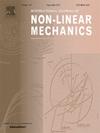Multi-objective optimization of the asymmetric-grinding rail profile for sharply curved tracks on metro line
IF 2.8
3区 工程技术
Q2 MECHANICS
International Journal of Non-Linear Mechanics
Pub Date : 2025-02-24
DOI:10.1016/j.ijnonlinmec.2025.105065
引用次数: 0
Abstract
Rail grinding is an effective strategy to improve the curve negotiation performance of metro vehicles. This paper develops a multi-objective optimization model for the design of the asymmetric-grinding rail profiles. The root-mean-square value of the derailment coefficient and the mean value of the rail wear of high rail are taken as two optimization objectives. A surrogate model, established using the results of the vehicle-track coupled dynamics simulations and non-uniform rail wear predictions, is used to calculate the optimization objectives. The multi-objective particle swarm optimization (MOPSO) model is applied to solve the multi-objective optimization model. The asymmetric-grinding rail profile of a sharp metro line is optimized by using the developed model, and the Pareto front of the multi-objective optimization problem is obtained. The performance of three typical asymmetric-grinding rail profiles in vehicle dynamics and rail wear rate is analyzed by comparing them with those of the original rail profile. The simulation results show that the optimized asymmetric grinding of rail profiles achieves the optimization objectives of reducing both the derailment coefficient and the mean value of rail wear on high rail. Due to the conflicting relationship between the two objective functions, an optimized asymmetric-grinding of rail profiles in the Pareto front that could balance both the wheel-rail safety and rail wear is chosen as the best rail grinding strategy.
地铁急弯轨道非对称磨削型线的多目标优化
磨轨是提高地铁车辆曲线通过性能的有效策略。建立了非对称磨削钢轨轮廓设计的多目标优化模型。以高铁脱轨系数的均方根值和钢轨磨损的平均值为优化目标。利用车辆-轨道耦合动力学仿真结果和非均匀钢轨磨损预测结果建立代理模型,计算优化目标。采用多目标粒子群优化(MOPSO)模型求解多目标优化模型。利用所建立的模型对某尖锐地铁线路的非对称磨轨轮廓进行了优化,得到了多目标优化问题的帕累托前沿。对比分析了三种典型非对称磨削钢轨的动力学性能和钢轨磨损率。仿真结果表明,优化后的钢轨轮廓非对称磨削达到了降低脱轨系数和钢轨平均磨损值的优化目标。考虑到这两个目标函数之间的冲突关系,选择了兼顾轮轨安全和钢轨磨损的帕累托前沿钢轨轮廓优化非对称磨削策略作为最佳钢轨磨削策略。
本文章由计算机程序翻译,如有差异,请以英文原文为准。
求助全文
约1分钟内获得全文
求助全文
来源期刊
CiteScore
5.50
自引率
9.40%
发文量
192
审稿时长
67 days
期刊介绍:
The International Journal of Non-Linear Mechanics provides a specific medium for dissemination of high-quality research results in the various areas of theoretical, applied, and experimental mechanics of solids, fluids, structures, and systems where the phenomena are inherently non-linear.
The journal brings together original results in non-linear problems in elasticity, plasticity, dynamics, vibrations, wave-propagation, rheology, fluid-structure interaction systems, stability, biomechanics, micro- and nano-structures, materials, metamaterials, and in other diverse areas.
Papers may be analytical, computational or experimental in nature. Treatments of non-linear differential equations wherein solutions and properties of solutions are emphasized but physical aspects are not adequately relevant, will not be considered for possible publication. Both deterministic and stochastic approaches are fostered. Contributions pertaining to both established and emerging fields are encouraged.

 求助内容:
求助内容: 应助结果提醒方式:
应助结果提醒方式:


